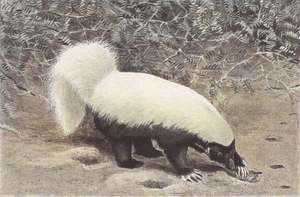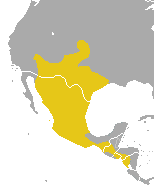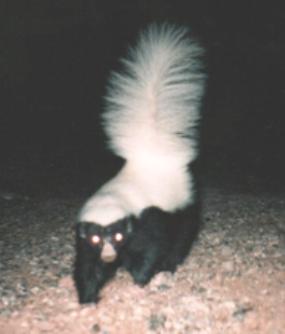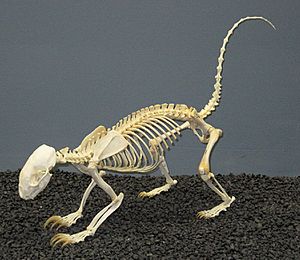American hog-nosed skunk facts for kids
Quick facts for kids American hog-nosed skunk |
|
|---|---|
 |
|
| Conservation status | |
| Scientific classification | |
| Genus: |
Conepatus
|
| Species: |
leuconotus
|
 |
|
| Conepatus leuconotus range | |
The American hog-nosed skunk (Conepatus leuconotus) is a type of hog-nosed skunk. It lives in Central America and North America. This skunk is one of the biggest skunks in the world! It can grow up to 2.7 feet (82 cm) long. Scientists recently found that the western hog-nosed skunk is actually the same species. So, Conepatus leuconotus is now the official name for all of them.
In Texas, people often call it the rooter skunk. This is because it likes to dig around and flip over rocks to find food.
Contents
What Does the American Hog-Nosed Skunk Look Like?
The American hog-nosed skunk has a special look. It has one wide white stripe that goes from its head all the way to its tail. Its tail is completely white. This skunk is the only one that doesn't have a white dot between its eyes. Its body fur is mostly black.
The snout (nose) of this skunk is quite long. It has a bare nose pad, which looks a lot like a small pig's nose. This nose pad is about three times wider than that of a striped skunk. Its ears are small and round, and its eyes are also quite small. The fur on its body is short and feels a bit rough.
American hog-nosed skunks have strong, thick legs. They walk with their whole foot touching the ground, like humans. Their back feet are wide and large. The bottom half of their soles are bare. Their upper body is very strong. Their front claws are very long. These skunks can be from 44.4–93.4 cm (17.5–36.8 in) long. They usually weigh between 1,130–4,500 g (2.49–9.92 lb). Male skunks are usually about 10% bigger than females.
This skunk is built for digging. In this way, it is more like a badger than other skunks. Its strong front legs and special shoulder bones help it dig well. Its nostrils point downwards. This helps them use their excellent sense of smell. They use their nose to find and catch food buried underground. These skunks can also climb, but they are not as good at it as spotted skunks.
How Do They Have Babies?
American hog-nosed skunks usually have babies from late February to early March. Most adult females are pregnant by the end of March. Pregnancy lasts about 60 days. The babies are born in April and May. Young skunks are often seen by late July or mid-August. By late August, the young skunks start to move out on their own. A mother skunk usually has one to five babies at a time. However, two to four babies are most common.
Where Do They Live and What Do They Eat?
These skunks live in places like canyons, along streams, and in rocky areas. In Mexico, they have been found in many different homes. These include open deserts, grasslands, tropical areas, and mountains. They also live near farms, in thick bushes, and in forests with trees like live-oaks and pecans. You can also find them in pine forests and areas with lots of cacti. In Texas, they live in bushy areas, pastures, and natural grasslands. These areas are mostly used for raising cattle. Thorny bushes and cactus are common plants where these skunks live in southern Texas.
The American hog-nosed skunk is an omnivore. This means it eats both plants and animals. It mostly eats insects and plants. But it will also eat small mammals and reptiles if it can find them. Farmers sometimes think these skunks are pests because they dig. However, skunks usually prefer insects over farm crops. Like all skunks, they have strong scent glands. They use these to spray a stinky liquid to scare away animals that might attack them.
Different Types of Hog-Nosed Skunks
There are three types (subspecies) of American hog-nosed skunks. One of them might be extinct.
- C. l. leuconotus (eastern hog-nosed skunk) – Found in Texas, New Mexico, Arizona, Mexico, Guatemala, Honduras, Nicaragua.
- C. l. figginsi (Furnace Canyon hog-nosed skunk) – Found in Colorado.
- C. l. telmalestes (Big Thicket hog-nosed skunk)† – Used to live in Oklahoma and southeastern Texas. (The "†" means it's extinct).
Are They in Danger? (Conservation)
Most American hog-nosed skunks are not in danger. But one type, the Big Thicket hog-nosed skunk (C. l. telmalestes), is now considered extinct. This was decided by the IUCN.
Overall, this species is not a big worry for conservation around the world. But in some states, it is considered threatened. For example, in Colorado, it was listed as "critically imperiled" in 2006. This means there were five or fewer records of them, or less than 1,000 skunks in the state. In New Mexico and Oklahoma, it was "Imperiled" in 2006. This means there were six to 20 sightings, or less than 3,000 skunks.
However, in Texas and Arizona, there are many of these skunks. So many, in fact, that people can legally hunt them all year. The United States Forest Service calls them a "fur bearer."
See also
 In Spanish: Zorrillo cadeno para niños
In Spanish: Zorrillo cadeno para niños




